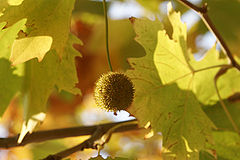Platanus × acerifolia
| Habit | tree
| |
|---|---|---|
| Height: | ⇕ | 30 ft"ft" can not be assigned to a declared number type with value 30. to 70 ft"ft" can not be assigned to a declared number type with value 70. |
| Lifespan: | ⌛ | perennial |
| Exposure: | ☼ | sun |
|---|---|---|
| Water: | ◍ | moist |
| Features: | ✓ | deciduous |
| USDA Zones: | 5 to 8.5 |
|
Platanus > |
Platanus × acerifolia, the London plane, London planetree, or hybrid plane, is a tree in the genus Platanus. It is usually thought to be a hybrid of Platanus orientalis (oriental plane) and the Platanus occidentalis (American sycamore). Some authorities think that it may be a cultivar of P. orientalis.
The London Plane is a large deciduous tree growing to 20–35 m (exceptionally over 40 m) tall, with a trunk up to 3 m or more in circumference. The bark is usually pale grey-green, smooth and exfoliating, or buff-brown and not exfoliating. The leaves are thick and stiff-textured, broad, palmately lobed, superficially maple-like, the leaf blade 10–20 cm long and 12–25 cm broad, with a petiole 3–10 cm long. The young leaves in spring are coated with minute, fine, stiff hairs at first, but these wear off and by late summer the leaves are hairless or nearly so. The flowers are borne in one to three (most often two) dense spherical inflorescences on a pendulous stem, with male and female flowers on separate stems. The fruit matures in about 6 months, to 2–3 cm diameter, and comprises a dense spherical cluster of achenes with numerous stiff hairs which aid wind dispersal; the cluster breaks up slowly over the winter to release the numerous 2–3 mm seeds.
Cultivation
Propagation
Pests and diseases
Varieties
Cultivars and varieties:
- Augustine Henry. This is a tall growing variety, with very large, pale green leaves. It produces a strong leader and a cylindrical trunk.[1]
- Bloodgood, This is one of the first cultivars to be selected for anthracnose resistance. It is a rounded tree with deep green leaves that turn a poor yellow in fall. The plant tolerates poor cultural conditions, including heat, drought and poor soil. Recent observations indicate susceptibility to ozone.
- Columbia. Resists mildew and anthracnose, this tree has deeply-lobed, dark green leaves.[2]
- Liberty. A U.S. National Arboretum introduction, this pyramidal tree grows vigorously. It shows good tolerance for mildew, anthracnose, heat and drought.[2]
- Metzam (Metroshade), A new introduction that grows strongly with a pyramidal habit, this cultivar is also said to be disease resistant with lustrous green foliage that emerges with a reddish cast.[2]
- Mirkovec. Has a dwarf, shrubby habit and unusual variegated lobed leaves with pink, cream and bronze regions.[2]
- Pyramidalis. A cultivar or cultivar group common in London, with rich glossy green leaves, and a characteristic tendency to produce straight branches, compared to sinuous branches ones in other forms.[1]
- Suttneri. Leaves are variegated creamy white.
- Yarwood. Very resistant to powdery mildew and highly susceptible to anthracnose. Poor structure. Being abandoned in California.[3]
Gallery
References
External links
- w:Platanus × acerifolia. Some of the material on this page may be from Wikipedia, under the Creative Commons license.
- Platanus × acerifolia QR Code (Size 50, 100, 200, 500)



